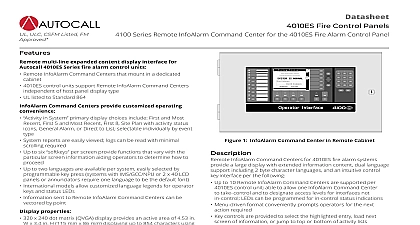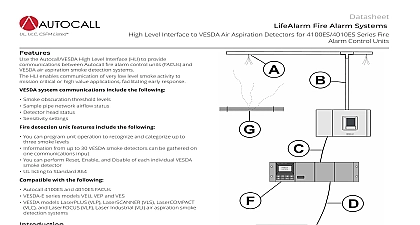Autocall MX Loop Interface Modules for 4100ES and 4010ES Fire Alarm Control Panels; International

File Preview
Click below to download for free
Click below to download for free
File Data
| Name | autocall-mx-loop-interface-modules-for-4100es-and-4010es-fire-alarm-control-panels-international-7963418520.pdf |
|---|---|
| Type | |
| Size | 4.88 MB |
| Downloads |
Text Preview
UL ULC CSFM Listed Control Panel Modules Loop Interface Modules for 4100ES and 4010ES Fire Alarm Control Panels MX Technology addressable devices to a Autocall 4100ES 4010ES fire alarm control panel Connect up to 250 MX addressable devices with up to 500 mA of current per MX Loop module Up to 30 MX Loop Interface Modules per 4100ES fire alarm control Up to 4 MX Loop Interface Modules per 4010ES fire alarm control Provides dual isolated Class B loops that can be connected together Class A operation Device LEDs for alarm activation are selectable per loop as 5 10 20 or to be activated simultaneously LED blink on poll is also selectable loop On board LED diagnostics indicated module status for installation and convenience Compatible with 4100ES and 4010ES panels with software revision or higher and MX loop module software 2.01 or higher Supports Local Mode operation when module is mounted in MINIPLEX UL listed to Standard 864 Loop Communications provide Compatibility with many types of existing cable for convenient retrofit typical communications distances up to 2 km 6560 ft Wiring lengths may be longer depending on wiring characteristics and conditions consult your Autocall product representative for details advanced MX Loop Module provides the following features Information communicated to the control panel is analyzed using the Fastlogic algorithm The MX Fastlogic algorithm is considered an Expert algorithm that uses fire data as a basis for the alarm decision WALKTEST system testing with automatic self resetting is available for mode select SIG OFF Peripherals provide Soft addressing of devices performed using the 850EMT programming Device addresses may be changed at the front panel addressable devices include Smoke sensors heat sensors and combination smoke heat sensors Sensor base operation is available with loop powered sounder or or with separately powered sounder Loop powered beacons and sounder beacons Single dual and multiple I O modules Relay signal monitor and separate line powered isolator modules Indoor and outdoor breakglass callpoints Single and dual action manual stations Voltage Regulator Module A100 5130 or A010 9917 provides regulated DC voltage for use with Monitor ZAMs 1 Loop Interface Module Basic Reference Compatibility applications requiring compatible Autocall fire alarm control features to be applied to UL listed versions of MX Technology the MX Loop Interface Module provides the necessary monitoring and control for up to 250 addressable MX per loop Multiple MX Loop Interface Modules can be installed increased capacity LEDs provide service level module status indications for earth monitoring device response and loop power Technology Features Fastlogic operation for photoelectric sensors and photoelectric heat sensors This product has been approved by the California State Fire Marshal CSFM pursuant to Section 13144.1 of the California Health and Safety Code See CSFM Listings 7300 2269 0506 7165 2269 0542 and 7165 2269 0541 for allowable values and or conditions concerning material presented in this document Additional listings may be applicable contact your local supplier for the latest status Rev 10 2 2021 Loop Interface Modules for 4100ES and 4010ES Fire Alarm Control Panels Fastlogic Sensor Operation Fastlogic sensor operation is an algorithm that takes into account the pattern of smoke build up over time and applies fuzzy logic to calculate the of risk This algorithm uses over 200 years of fire test data from research at the University of Duisburg Duisburg Germany to determine the that there is a real fire and is designed to achieve faster detection of real fires and slower preferably no detection of false alarm sources Fastlogic Sensor Basics MX Fastlogic algorithm can be described as an Expert algorithm since it uses real fire data as a basis for the alarm decision For any given we are obliged to employ the most suitable detection in terms of response to an actual fire while minimizing false alarms This general is clearly reflected in local and national standards governing fire detection system designs attempts at reducing the occurrence of false alarms have involved degrading the level of fire protection afforded either by raising the threshold of smoke sensors introducing delays or generally employing less responsive detection MX Fastlogic sensors give us the opportunity offer an improved level of protection while simultaneously increasing immunity to false alarm Fastlogic Algorithm Principle Elements elements of the sensor output are monitored and this raw data is used by MX Fastlogic algorithm to execute a series of processes to evaluate probable presence of fire including Background filtering Instantaneous smoke density Rate of change of smoke density Smoke density weighting Smoke density peak suppression Real fire comparison synonymous with false alarms are filtered while those elements indicative of fire are weighted These results are continually compared data derived from real fires to produce a measure of fire risk It is against this risk measurement that the decision to alarm is made Sensitivity and Minimizing False Alarms Fastlogic sensors are designed to maintain sensitivity to fire while minimizing false alarms Many analog detection systems allow the user to select smoke sensor sensitivity settings e g High Normal or Low sensitivity Lowering the sensitivity setting is a typical reaction to unwanted alarms it usually means that a greater density of smoke is required to initiate an alarm This is not the case for sensors using MX Fastlogic operation which comparing the real fire experience against recognized fire patterns Changing sensitivity from to for example would delay responses to likely fire patterns while maintaining a normal response to more likely fire patterns The net result is a reduced sensitivity to possible false alarms reducing sensitivity to clearly identifiable fires Fastlogic algorithm availability Fastlogic operation is available for MX photoelectric sensors and photoelectric heat sensors These devices are used in both life protection and protection applications providing reliable early detection of real fires Addressing technology sensors and addressable devices are addressed using the 850EMT programming tool which presents a simple menu driven interface that can automatically increment addresses following each write operation This simple to use soft addressing technique avoids errors that often occur when coded switches are used 850EMT programming tool can also change addresses stored in a sensor or other addressable device non volatile memory which makes errors easy to rectify Information MX Devices Instructions Reference Instructions Reference 1 Additional Information AC4100 1031 to Product Selection and Reference 2 Rev 10 2 2021 Loop Interface Modules for 4100ES and 4010ES Fire Alarm Control Panels Selection and Peripherals Reference 2 MX Loop Interface Module Loop Interface Module for 4100ES fire control panels PDI connection module mounts in CPU bay expansion bay or transponder requires 2 vertical blocks to four 4 modules can be powered from one EPS ES PS or ES XPS Loop interface module for 4010ES fire control panels 4100ES with SPS For CPU bay mounting A100 9867 Mounting Kit with is required ordered separately see below 4100ES with EPS ES PS or ES XPS Mounts in available CPU bay block to connect power from the CPU bay to the second bay harness is required ordered separately see below to data sheet AC4010 0006 for additional mounting information The A100 3118 Master Controller MX Loop Interface Module provides the same module and specifications as the A100 6077 but is dedicated as a Controller feature selection see AC4100 1031 for additional information 3 MX Loop Interface Module Mounting Accessories Bay Mounting Kit for SPS Master Controller Loop Interface Module Power Harness for EPS ES PS Master Controller to mount the A100 6077 MX Loop Module in the CPU bay of a 4100ES SPS includes harnesses for connection to a second bay without requiring a supply in that bay connectio


